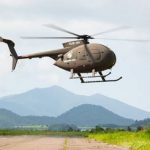 On July 30, Korean Air successfully completed the inaugural flight of KUS-VH, the 500MD unmanned helicopter. The flight lasted for about 30 minutes, at Korea Aerospace Research Institute’s aviation center located in Goheung, South Jeolla Province, Korea. The 500MD unmanned helicopter took off and hovered 10 meters (30ft) above the ground, showcasing the capabilities and functionality of the unmanned flight control system.
On July 30, Korean Air successfully completed the inaugural flight of KUS-VH, the 500MD unmanned helicopter. The flight lasted for about 30 minutes, at Korea Aerospace Research Institute’s aviation center located in Goheung, South Jeolla Province, Korea. The 500MD unmanned helicopter took off and hovered 10 meters (30ft) above the ground, showcasing the capabilities and functionality of the unmanned flight control system.
Korean Air has been modifying 500MD helicopters to turn them into unmanned helicopters since 2014 through a series of programs, including a technology development project of Korea’s Ministry of Trade, Industry and Energy.
Korean Air will gradually expand the unmanned helicopter’s flight range and operational altitude by continuing its development until 2021, to accommodate potential customer requirements, to demonstrate the flight performance of the 500MD unmanned helicopter and its capability to operate mission equipment such as EO/IR, SAR and AIS.
For the inaugural flight, Korean Air conducted ground tests, including a remote engine start to check the functionality and operation of unmanned systems, and tethered hover flight tests to validate the flight control system. The company then received a special airworthiness certification from the Defense Acquisition Program Administration.
The KUS-VH is equipped with a state-of-the-art system, featuring a flight control computer, tactical-EGI, propulsion control system, and electro-mechanical rotor actuators. After further development and once the mission equipment has been installed, it is expected to be utilized in various fields such as surveillance and reconnaissance during the daytime and nighttime.
The KUS-VH, which can stay airborne for 6 hours and carry a payload of 440 kilograms, is expected to facilitate early militarization at a low cost since it was developed by modifying a 500MD helicopter. The unmanned helicopter can be used to move the domestic supply of goods, coping with not only military demands but civilian ones. It can also enter the fast-growing overseas market.
“With the first flight of the 500MD unmanned helicopter, we demonstrated our unmanned helicopter technology. We also expect to extend this technology to other helicopters, including the UH-1H and UH-60, as well as to fixed-wing fighters, such as the F-5,” said Mr. Jong-koo Kang, Director of Korean Air’s Aerospace Research Institute. “We will continue our efforts to develop unmanned helicopters that can enter into not only domestic but also overseas markets, by actively and continuously incorporating user requirements.”

Korean Air combined its UAV technology with rotary wing unmanning technology to modify 500MDs no longer used by the Korean Army. While a number of unmanned helicopters such as Boeing’s Little Bird, Sikorsky’s unmanned UH-60, are developed as OPV configurations, Korean Air’s KUS-VH was designed to be completely unmanned from the initial stage to minimize the unit cost for mass-production.
Meanwhile, by launching 500MD military helicopters for the first time in Korea in 1976, Korean Air started the era of aircraft manufacturing. The company supplied F-5 fighters (Jegong-Ho) to the Republic of Korea Air Force, and UH-60 helicopters to the Korean army. The company produced 500MD helicopters from 1976 to 1988, and exported about 500 fuselages overseas. Korean Air also participated in the international joint development programs of airliners with world-class manufacturers, such as Boeing and Airbus, and was recognized for its design and production capabilities.
Through continuous investment in the UAV market since the late 1990s, Korean Air has evolved into the leader of the nation’s UAV industry, introducing various platforms such as tactical-reconnaissance UAV, MALE reconnaissance UAV, low-observable tailless UAV and VTOL UAVs such as Tilt-Rotor, 500MD unmanned helicopter, and hybrid-propulsion drone.
















